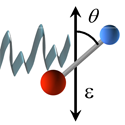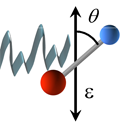Orientation without perturbation
Analyzing the structure of molecules in a gas or liquid is akin to x raying a classroom of unruly kids randomly jostling and changing their positions and orientations. Getting a handle on the detailed structure of molecules requires some means of lining them up to avoid orientational averaging and smearing. Researchers have developed techniques for orienting molecules, but so far they have relied on strong electric fields, which may perturb the molecules or interfere with some other aspect of the analysis. Taking advantage of femtosecond laser technology, Sankar De and colleagues from Kansas State University, US, and the Max Planck Institute in Garching, Germany, report in Physical Review Letters their success in achieving field-free orientation of carbon monoxide molecules.
De et al. used overlapping femtosecond pulses at and to excite odd and even angular momentum states of the molecules, enabling net macroscopic orientation. Changing the optical phase between the two pulses enabled the group to not only align the carbon monoxide molecules (i.e., with their molecular axes pointing the same direction) but orient them as well (i.e., all the carbons pointing in the same direction). Another pulse striking the molecules caused a “Coulomb explosion” and ejection of carbon ions that were detected to confirm the molecular orientation. By grabbing hold of molecules and orienting them neatly without strong fields, researchers should be able to carry out improved ultrafast structural imaging and molecular tomography. – David Voss





